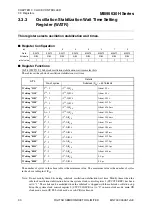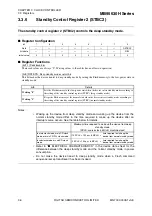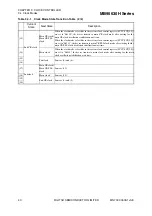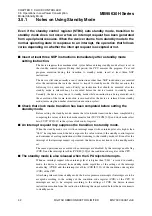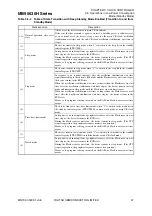
MB95630H Series
42
FUJITSU SEMICONDUCTOR LIMITED
MN702-00009-1v0-E
CHAPTER 3 CLOCK CONTROLLER
3.5 Operations in Low Power Consumption
Mode (Standby Mode)
3.5.1
Notes on Using Standby Mode
Even if the standby control register (STBC) sets standby mode, transition to
standby mode does not occur when an interrupt request has been generated
from a peripheral resource. When the device returns from standby mode to the
normal operating state in response to an interrupt, the operation that follows
varies depending on whether the interrupt request is accepted or not.
■
Insert at least three NOP instructions immediately after a standby mode
setting instruction.
The device requires four machine clock cycles before entering standby mode after it is set in
the standby control register. During that period, the CPU executes the program. To avoid
program execution during this transition to standby mode, insert at least three NOP
instructions.
The device still runs normally even if instructions other than NOP instructions are inserted
after the instruction that sets the device to transit to standby mode. On this occasion, the
following two events may occur. Firstly, an instruction that should be executed after the
standby mode is released may be executed before the device transits to standby mode.
Secondly, the device may transit to standby mode while an instruction is being executed, and
the execution of that same instruction is resumed after the device is released from standby
mode (increasing the number of instruction execution cycles).
■
Check that clock mode transition has been completed before setting the
standby mode.
Before setting the standby mode, ensure that clock-mode transition has been completed by
comparing the values of the clock mode monitor bits (SYCC:SCM[2:0]) and clock mode select
bits (SYCC:SCS[2:0]) in the system clock control register.
■
An interrupt request may suppress the transition to standby mode.
When the standby mode is set with an interrupt request whose interrupt level is higher than
"0b11" having been issued, the device ignores the value written to the standby control register
and continues executing instructions without transiting to the standby mode set. Even after the
interrupt of that interrupt request is processed, the device does not transit to the standby mode
set.
The same operations are executed when interrupts are disabled by the interrupt enable flag
(CCR:I) and the interrupt level bits (CCR:IL[1:0]) of the condition code register of the CPU.
■
The standby mode is also released when the CPU rejects interrupts.
When an interrupt request whose interrupt level is higher than "0b11" is issued in standby
mode, the device is released from standby mode, regardless of the settings of the interrupt
enable flag (CCR:I) and the interrupt level bits (CCR:IL[1:0]) of the condition code register
(CCR) of the CPU.
After being released from standby mode, the device processes interrupts if interrupts are to be
accepted according to the settings of the condition code register (CCR) of the CPU. If
interrupts are not to be accepted according to the settings of CCR, the device resumes
instruction execution from the instruction following the one executed before the device transits
to standby mode.
Содержание MB95630H Series
Страница 2: ......
Страница 4: ......
Страница 8: ...iv ...
Страница 20: ...xvi ...
Страница 106: ...MB95630H Series 86 FUJITSU SEMICONDUCTOR LIMITED MN702 00009 1v0 E CHAPTER 6 I O PORT 6 2 Configuration and Operations ...
Страница 282: ...MB95630H Series 262 FUJITSU SEMICONDUCTOR LIMITED MN702 00009 1v0 E CHAPTER 14 LIN UART 14 8 Notes on Using LIN UART ...
Страница 642: ...MB95630H Series 622 FUJITSU SEMICONDUCTOR LIMITED MN702 00009 1v0 E APPENDIX A Instruction Overview A 5 Instruction Map ...
Страница 644: ......



